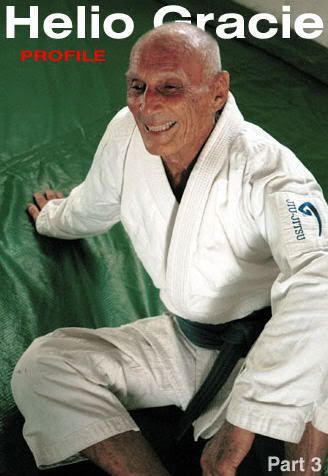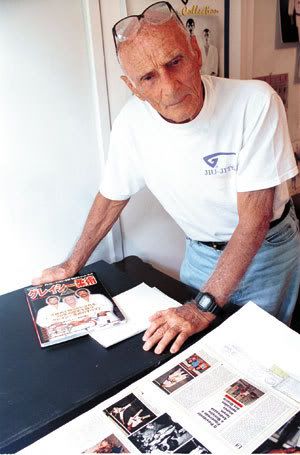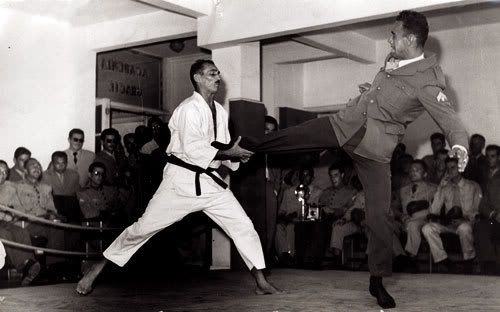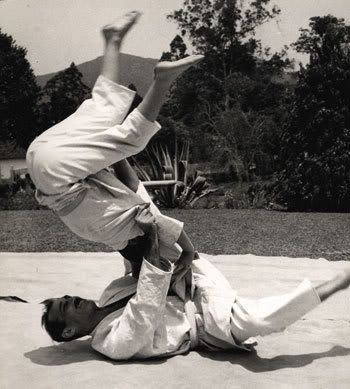Helio Gracie, part 3

By Graciemag
A COLOSSAL GYM: RETIREMENT INTERRUPTED; CHILDREN AND A NOT SO CONVENTIONAL CONJUGAL RELATIONSHIP; LOTS OF PHILOSOPHY AND JIU-JITSU. DIVE, FROM HERE ON, INTO THE CONCLUSION OF THE SAGA OF GRANDMASTER HELIO GRACIE... BUT DON'T GO TOO DEEP, OR YOU MAY BE BITTEN BY THE SHARKS OF ABROLHOS.
The year of 1952, following the year of his epic fight against the Japanese Kimura, stood out in the life of Grandmaster Helio. That was when his first legitimate son, Rorion, was born, and when he, along with his brother Carlos, inaugurated a massive gym on Rio Branco Avenue, in downtown Rio de Janeiro, which was kept running for 30 years. Also in ’52, Carlos bought a "house" in Teresópolis, which served as the setting for the weekends of the entire Gracie family until the 1980's.
“We had 600 students per month, with all the timeslots filled. Students would, sometimes, wait a whole year for an opening," Helio Gracie
Helio had announced his retirement after the big fight, and started dedicating himself to the administration of what was, according to him, the greatest Jiu-Jitsu academy of all times. “There has never been and will never be anything like it,” says the master with pride. “Although Rorion’s gym in California is more spacious, the Rio Branco organization was a business. It took up the whole floor of the building, with five rings and 100 private lessons per day. We had 600 students per month for over 20 years. Double what Rorion has these days,” he compares.
At the time there were no computers, but Hélio organized his entire contingent of students: as he explains: “When the student would sign up, he would receive an id card and pay his contractual fee. The student would come and pick up his card and go to the clothing booth. The academy would provide a gi and towel, when he would present his card at the clothing booth. The employee would then check to see if everything was in order (time, payment etc.) and he would hand over the little basket with the towel and gi. When the student would go to the dressing room, the employee at the clothing booth would call the secretary informing that the student had arrived at such and such a time. When he would go to the ring, another call was made to the secretary informing the time of entry. All of this she would make note of on the student's form. He would have his class and, when he left the ring, the teacher would go to the reception and turn in the class form signed by the student to the secretary.”
HELIO STILL KEEPS THE FORMS OF THE THOUSANDS OF STUDENTS THAT FREQUENTED THE OLD GRACIE ACADEMY. “THE OWNERS OF BRAZIL WOULD GO THERE," HE STATES. ABOVE, AN ILLUSTRIOUS STUDENT: MÁRIO ANDREAZZA, WHO WAS A MINISTER, DURING THE DAYS OF THE DICTATORSHIP.
THE GRACIE FAMILY SHIELD, WHICH WAS THE INSPIRATION FOR THE SYMBOL OF THE BRAZILIAN JIU-JITSU CONFEDERATION.
The team of instructors at the Gracie academy (Carlson and Robson Gracie, Hélio Vígio, Armando Wriedt and João Alberto Barreto were the ones that spent the most time teaching there) was rigorously supervised by Hélio: “I kept track and charged fines for lateness. The teacher had one minute to leave the ring with the student and bring in the next one, in between half-hour classes. Every minute over was a certain amount. If the student arrived late, he would leave at the right time. There was no make-up class, because there was no time for it. Sometimes, people would wait a whole year to sign up for their class. Everything was full, from seven in the morning to seven at night. The teachers ate in the gym, there was no time.”
As the academy provided the gis, the Gracies had a stock of 3,000 complete kits, manufactured by them. At the end of the week they would load up a pickup with 600 dirty gis and take them to the laundry, with two industrial laundry machines, they maintained in the house in Teresópolis. “One of them I still have in my house,” says the master, who used the gis to weed out weaknesses in the system. “I had the records on the gis we washed. It could not go over that count, I knew the number of classes by the number of gis, and I challenged the secretary to steal from me without my knowing it. But there was no way, the system was so complex that no one understood it completely, except me,” he says with pride, recalling one case: "Once, a secretary named Mary tried to pocket some money from an extra class. But, when I was looking over the student's form, I noticed he had taken a class outside of the normal schedule, and I asked her: ‘Where is the money from so-and-so’s extra class?’ She turned red and answered: ‘Didn’t you say I could take it?’ ‘So put it back,' I replied. The system was perfect.”
But the master’s demand that the gym be maintained just the way he wanted it was not limited to organization and punctuality. In fact, he was even more rigorous concerning method, which he says he perfected over the years, just like his Jiu-Jitsu. “We had internal phones everywhere. I would enter each ring for five minutes. If I knocked on the door and the teacher opened it, he would be fined. He could only open the door by calling first, and if it was me. And he had to teach the class the way I wanted it taught, because I teach for the student to learn, not to fool around. Nobody teaches like I do. I am a nitpicker, I only think about solving the student's problem. I love the student; I don't want to hear about anything else. Sometimes, the student is a little dumb, or awkward, but that is not his problem. And these inspections helped me find out when a teacher was impatient, intolerant, or bad at explaining things. At the end of the day, I would call everyone over and question them."

HE NEVER TOOK A BREAK FROM JIU-JITSU. ON SUNDAYS, THE MASTER WOULD LAY OUT CANVAS ON THE GRASS OF HIS HOUSE IN TERESÓPOLIS TO TRAIN WITH THE FAMILY AND CLOSE FRIENDS.
Despite the discipline adopted, Hélio would praise his teachers: “They were good. Sometimes I would go over the method again with each one, and work on their morale. If I caught someone saying, 'So-and-so, lie down,' I would notice. ‘Lie down,’ no way! It’s ‘Mr. So-and-so, would you please lie down?” They were little things, but they made up the method. The student must feel respected. We taught presidents, ministers of the state. Can you imagine: ‘Lie down, Figueredo?’ Deep down the guy doesn’t like it. He would already step on the mat cowering, as he was physically inferior, and the instructor should not use strength to hurt the guy’s self-esteem. So, I had a way to keep the student, by way of attention, out of politeness, a set of things that keep the student. As I tell my kids, the student only stays away from the gym because of sickness, travel or a lack of money. There is no other reason. What other reason would they have for not doing what they enjoy?" he challenges.
It happens that there was something that caused the Gracie academy to empty out in the 70s: the traffic. "Downtown grew a lot and, all of a sudden, no one could stop their car near the academy. We would teach 200 children classes, but their parents would bring there kids and nowhere to park near the gym. So we lost a large part of our clientele,” explains Hélio, telling of what transpired next: “I ended up closing the gym and teaching at Vasco da Fama. After some time, I moved to Padre Antônio Vieira highschool, where my sons Royler and Rolker are to this day.”
Public challenge
One of the most famous challenges Hélio Gracie ever made was to the American boxer Joe Lewis. Everything started seven years before he arrived in Brazil. In 1943, the magazine Seleções published an article stating that a boxer had beaten a Jiu-Jitsu fighter, in a fight to demonstrate the superiority of one style over the other. Even though he knew the fighter was not from the Gracie Academy, Hélio felt offended and proposed to fight five boxers from any nation, with or without gloves, in a single evening.
The challenge was published in the O Globo newspaper, but nobody accepted the test. But in 1950, Lewis came to Brazil, and Hélio say the opportunity to avenge the Jiu-Jitsu’s reputation. This time, he challenged only the American, in a telegram printed on the cover of the periodical: "I have just learned of the possible arrival of Joe Lewis, ex-world boxing champion, in our capital. I would like to notify everyone possible that I would like to face him in a fight between boxing and Jiu-Jitsu to prove the superiority of the art I practice, as well as to clear up the doubts raised by the magazine Seleções. Hélio Gracie"
The press went wild with the telegram, and there was almost daily coverage of the challenge. But, to Hélio’s chagrin, Joe Lewis never accepted the proposal. The response of the American's agent was as follows: "To all sportsmen in Brazil: this telegram is to confirm the declaration that Joe Lewis, ex-world champion of boxing, admires all sportsmen in their respective areas, and will accept any challenge from anybody wanting to box with him. We want to thank the press and radio for the consideration given us, and would like to let the good people of Brazil know that we will never forget them. Sincerely, Marshall Miles, Joe Lewis' manager."
(Read More)






















No comments:
Post a Comment